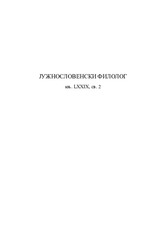РАДНИ ГЛАГОЛСКИ ПРИДЕВ М. Р. ЈД. У ГОВОРИМА КОСОВСКОГ ПОМОРАВЉА
PAST VERB FORM OF THIRD PERSON MASCULINE SINGULAR IN THE VERNACULARS OF KOSOVSKO POMORAVLJE
Author(s): Tatjana G. TrajkovićSubject(s): Lexis, South Slavic Languages, Philology, Phraseology
Published by: Институт за српски језик Српске академије наука и уметности
Keywords: Serbian language; Prizren-South-Moravian dialect; Kosovsko Pomoravlje; past verb form of third person masculine singular;
Summary/Abstract: The paper provides an overview of the state of the past verb form of the third person masculine singular in the vernaculars of the Kosovsko Pomoravlje region. The languages of this area belong to the Prizren-South-Moravian dialect of the Serbian language, and the category of past verb form is one of its specifi cities. The main goal of this research was to determine the state of the past verb form of the third person masculine singular in the vernaculars of Kosovsko Pomoravlje. This paper gives an overview of the forms represented in the vernaculars of Novo Brdo, Kosovska Kamenica, Gnjilane and Vitina regions. It was established that the forms that end with -ja (radija) are present in verbs with a vocal base, while in verbs with a consonant base the suffi x -a (iša) is used, provided that -ja or -aja (išja, išaja) are occasionally also used. Given the indications that this form is correlated with the third person plural present, these forms were followed in the same vernaculars. Since the form of the past verb form of the third person masculine singular is phonetically linked to the refl ex of the fi nal l, other types of words with -l or its different refl exes followed simultaneously. In addition to the unfi xed past verb form of the third person masculine singular in these vernaculars, the present form of idev can be heard sporadically with ideju. Inconstancy is also confi rmed in the realization of the fi nal l in other types of words, because forms with -l and -a are used simultaneously: pepel – pepeja and pepe. The conclusion is that in the vernaculars of Kosovsko Pomoravlje its state is insuffi ciently fi nalized in terms of the development of forms with fi nal l, which refers to the past verb form of the third person masculine singular and to other word types, with the fact that they are accompanied by forms of the present tense third person plural. These conclusions confi rm the assumption that the categories of the past verb form of the third person masculine singular and the present of the third person plural can correlate, to which one should certainly add the realization of -l with nouns, adjectives and adverbs. In order to establish a complete picture of the spread of the abovementioned forms, the conditions in other nearby and slightly more distant dialects were analyzed, as well as the vernaculars of Preševo, Bujanovac, Vranje, Pčinja, Kumanovo, Skopska Crna Gora, Letnica, Gatnje, Sirinić, Prizren, Podrima, Sretečka župa and Gora. It was concluded that the most stable state is shown in the vernaculars of Preševo, Bujanovac, Vranje, Gornja Pčinja and Kumanovo. In those of Prizren and Gatnje, stability is also observed due to the use of -a, but not -ja in the corresponding forms. This state is accompanied by the stability of the plural -v present, and this is again best recognized in more Eastern spoken languages. Apart from that, it can be added that they keep -l in other word types: nouns, adjectives and adverbs. The summarized results of the entire research are presented in a table and on a map.
Journal: Јужнословенски филолог
- Issue Year: 79/2023
- Issue No: 2
- Page Range: 151-170
- Page Count: 20
- Language: Serbian

